Unit 4 Natural disasters Project & Video Time课件(26页) 2024-2025学年高一英语人教版(2019)必修第一册
文档属性
| 名称 | Unit 4 Natural disasters Project & Video Time课件(26页) 2024-2025学年高一英语人教版(2019)必修第一册 | 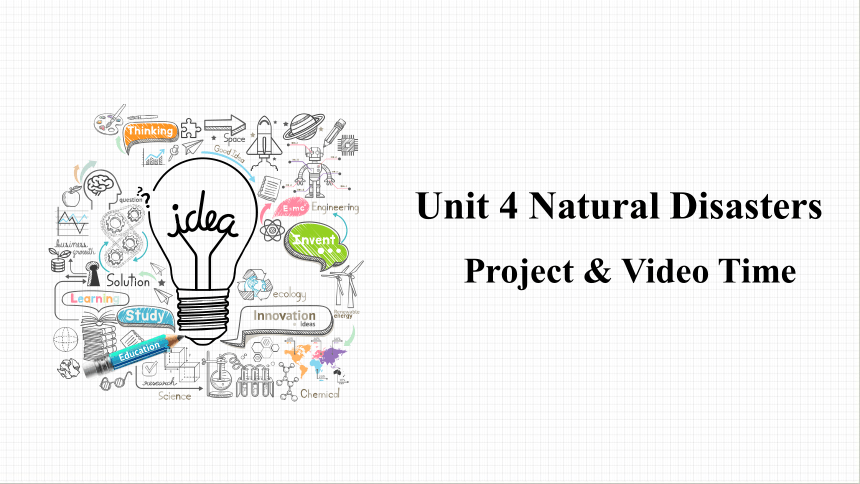 | |
| 格式 | pptx | ||
| 文件大小 | 77.3MB | ||
| 资源类型 | 教案 | ||
| 版本资源 | 人教版(2019) | ||
| 科目 | 英语 | ||
| 更新时间 | 2024-10-09 16:28:32 | ||
图片预览

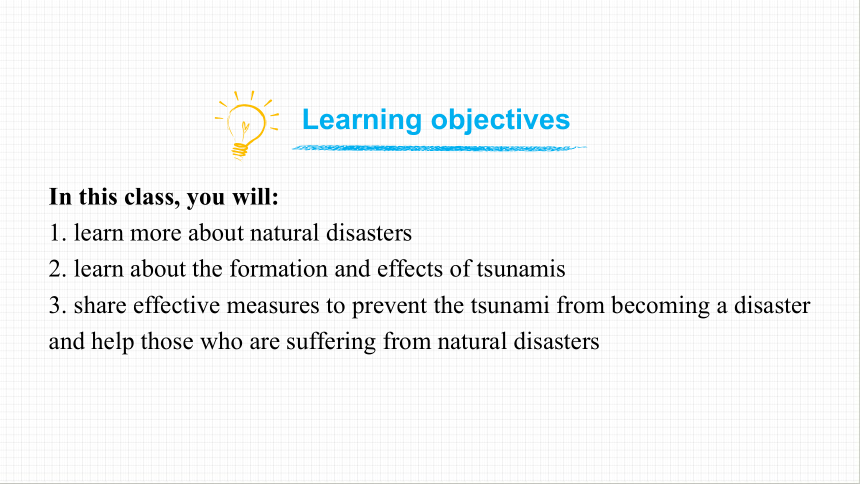

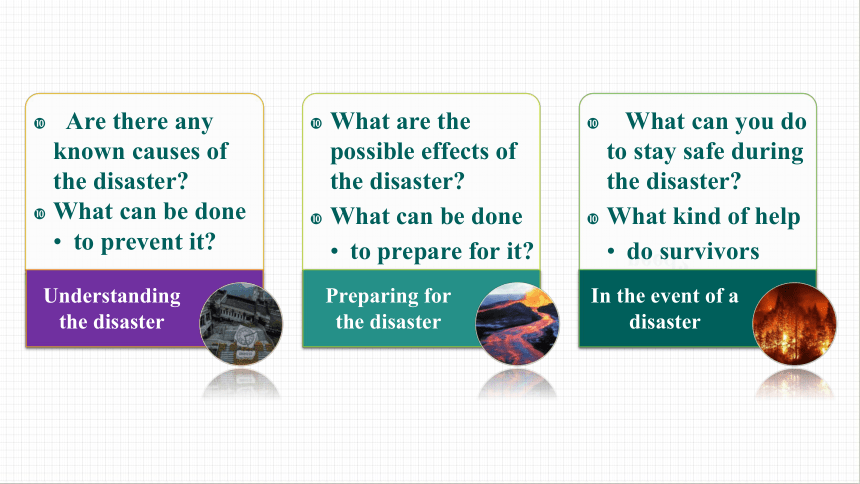
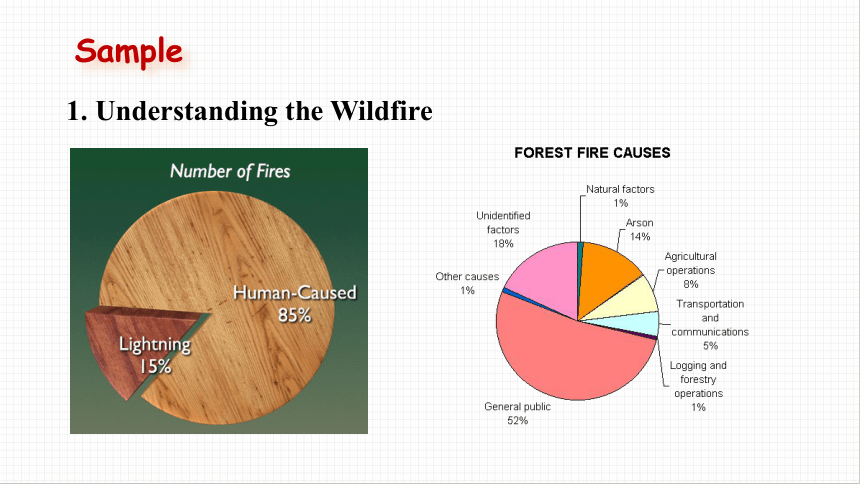

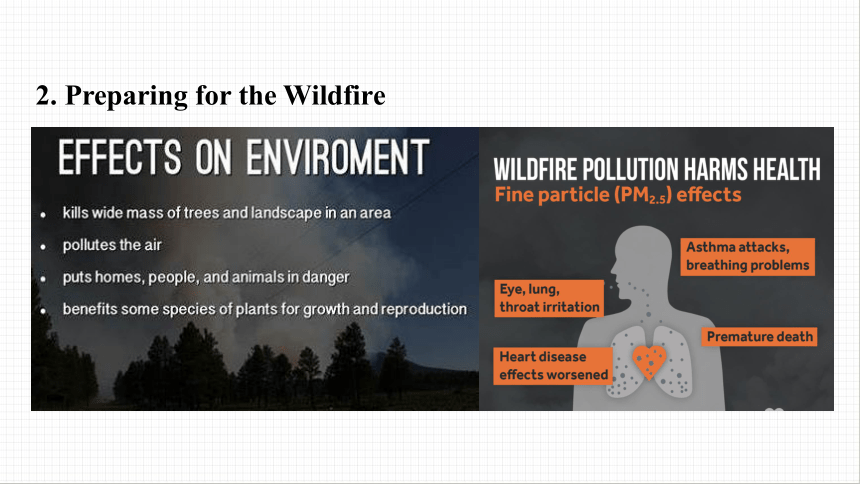
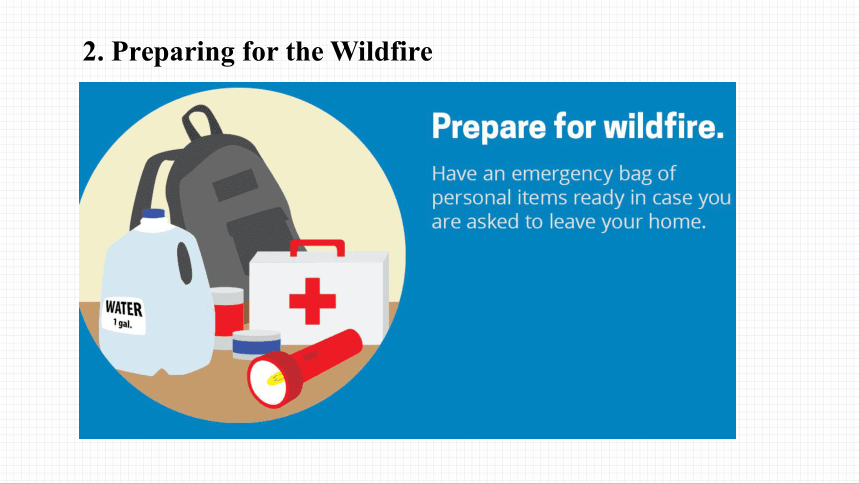
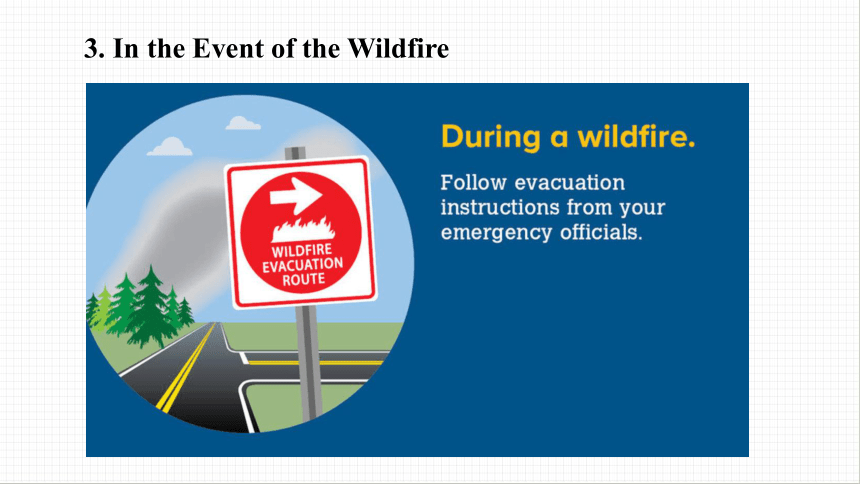
文档简介
(共26张PPT)
Unit 4 Natural Disasters
Project & Video Time
In this class, you will:
1. learn more about natural disasters
2. learn about the formation and effects of tsunamis
3. share effective measures to prevent the tsunami from becoming a disaster and help those who are suffering from natural disasters
Learning objectives
BRAINSTORM:Work in groups of three or four. Choose one of
the natural disasters below and brainstorm answers to the questions.
earthquake
tornado
wildfire
drought
landslide
avalanche
tsunami
flood
famine
typhoon
volcanic eruption
Give a presentation on natural disasters
Project
1
1. Understanding the Wildfire
Sample
1. Understanding the Wildfire
2. Preparing for the Wildfire
2. Preparing for the Wildfire
3. In the Event of the Wildfire
What kind of help do survivors need
3. In the Event of the Wildfire
2
RESEARCH: Which questions do you not know the answers to Which ones do you need more information on Use the Internet or your school library to find out more.
3
ORGANISE: Put together a presentation using the information you have gathered. Use the tips below to help you.
·Start your presentation with a "hook" (a story or fact to catch the
attention of your listeners).
On Monday, 5 September 20XX, 600 people disappeared when ...
·Reduce your ideas to three main points to help listeners remember
what you say.
So always remember to drop, cover, and hold on. ...
·Prepare visual aids for your presentation (photos, charts, tables, etc.).
4
PRESENT: Give a group presentation to your class.
Thousands of people in Northern California were told to leave their homes in November 2018 because of spreading wildfires. Officials said the fire started as a result of lightning strikes (雷击). This is just one of the many wildfires that happened in 2018. Then how much do you know about wildfires
Wildfires are usually caused by human and natural factors (like lightning, etc.). When wildfires begin, they may threaten people and /or their personal property. So we should try to prevent them. Forest managers should be hired to protect the forest and people should be educated about prevention of forest fires.
Then what should we do when a wildfire begin We should first inform people nearby about it and evaluate them to safe places. We should try to stay calm and move to safe places as soon as possible. After the wildfire, we should provide survivors shelters to rest and medicine help for the injured.
Sample 1
On 12 May, 2008, an 8.0-magnitude earthquake happened in Wenchuan which killed over 80,000 people and left many more injured, turning many towns and counties into ruins. At the moment, numerous children lost their parents and became orphans, hundreds of families were broken, and all the people there felt helpless and frightened.
Fortunately, lots of rescue workers rushed to the area and worked around the clock, and meanwhile supplies were being sent there from all directions. With the help from all Chinese people and even abroad, some victims finally survived, and their homes have also been rebuilt. Wenchuan city has proved to China and the rest of the world that in face of disaster, people must unify and never give up.
Sample 2
It has been more than ten years since the earthquake happened, but we’ll never forget its disastrous damage and sorrow and sadness. There is no way to prevent earthquakes. But if we prepare, we can keep them from becoming disasters. If you find yourself in danger from an earthquake, first of all, remember to “drop, cover, and hold on”. Drop down onto your hands and knees, cover your head with your hands, and stay away from glass, windows, or anything that could fall. You could find cover under a desk or table. Hold on to the desk or table so it doesn’t move away from you. Second, if you are outside when quakes happen, you should go to an open space away from buildings, trees, or power lines. If you are trapped, you can use a cell phone to call or text for help. You can also tap on a pipe or a wall, or whistle for help. Then you are more likely to be found. Do get your family and friends to be familiar with the self-help knowledge.
Read the sentences about the formation and effects of tsunamis. Then match each sentence with the correct picture.
A Tectonic plates push together.
B A series of waves expands in all directions.
C Whole sections of cities are destroyed.
C
B
A
Video Time
BEFORE YOU WATCH
Video Time
1 Decide whether the statements are true (T) or false (F).
1. There are few warning signs just before a tsunami hits.
2. A tsunami breaks just like an ordinary wave but is bigger.
3. Scientists at the Pacific Tsunami Warning Center monitor the earth’s movements 24 hours a day in order to track tsunami.
A tsunami wave doesn’t break like an ordinary wave.
T
F
T
WHILE YOU WATCH
2 Circle the correct word(s) in each sentence.
1. An earthquake occurs when plates below the earth’s surface push together/pull apart.
2. Tsunami waves deep at sea move fast and rise only a few/hundreds of feet.
3. As these killer waves enter shallow waters, their speed is reduced/raised.
4. Most tsunami damage is caused when the waves come in from/move back out to the sea.
Work in pairs. Discuss the questions.
1. What have you learnt about tsunamis
They aren’t noticeable or strong until they hit the coast.
dangerous
destructive
deadly
disastrous
sudden
AFTER YOU WATCH
2. What kind of help do you think people who have suffered from a tsunami need
They need food, water, shelter, etc. They may also need medical help and emotional help if they have lost loved ones.
3. How can we prevent the tsunami from becoming a disaster?
Scientists the earth’s movements 24hours a day in order to track tsunamis.
The scientists try to the wave will head and people in its path.
The advice is simple: the coastal areas and to higher ground. news that the danger has .
monitor
find out where
warn
leave
move
Wait for
passed
Let’s watch another video about tsunami.
Doing the project—give a presentation on natural disasters and watching the video —Tsunami:Killer Wave let us know how to survive from disasters better.
Summary
1. Make a poster to tell people about tsunamis.
2. Make a presentation on tsunamis.
Homework
Unit 4 Natural Disasters
Project & Video Time
In this class, you will:
1. learn more about natural disasters
2. learn about the formation and effects of tsunamis
3. share effective measures to prevent the tsunami from becoming a disaster and help those who are suffering from natural disasters
Learning objectives
BRAINSTORM:Work in groups of three or four. Choose one of
the natural disasters below and brainstorm answers to the questions.
earthquake
tornado
wildfire
drought
landslide
avalanche
tsunami
flood
famine
typhoon
volcanic eruption
Give a presentation on natural disasters
Project
1
1. Understanding the Wildfire
Sample
1. Understanding the Wildfire
2. Preparing for the Wildfire
2. Preparing for the Wildfire
3. In the Event of the Wildfire
What kind of help do survivors need
3. In the Event of the Wildfire
2
RESEARCH: Which questions do you not know the answers to Which ones do you need more information on Use the Internet or your school library to find out more.
3
ORGANISE: Put together a presentation using the information you have gathered. Use the tips below to help you.
·Start your presentation with a "hook" (a story or fact to catch the
attention of your listeners).
On Monday, 5 September 20XX, 600 people disappeared when ...
·Reduce your ideas to three main points to help listeners remember
what you say.
So always remember to drop, cover, and hold on. ...
·Prepare visual aids for your presentation (photos, charts, tables, etc.).
4
PRESENT: Give a group presentation to your class.
Thousands of people in Northern California were told to leave their homes in November 2018 because of spreading wildfires. Officials said the fire started as a result of lightning strikes (雷击). This is just one of the many wildfires that happened in 2018. Then how much do you know about wildfires
Wildfires are usually caused by human and natural factors (like lightning, etc.). When wildfires begin, they may threaten people and /or their personal property. So we should try to prevent them. Forest managers should be hired to protect the forest and people should be educated about prevention of forest fires.
Then what should we do when a wildfire begin We should first inform people nearby about it and evaluate them to safe places. We should try to stay calm and move to safe places as soon as possible. After the wildfire, we should provide survivors shelters to rest and medicine help for the injured.
Sample 1
On 12 May, 2008, an 8.0-magnitude earthquake happened in Wenchuan which killed over 80,000 people and left many more injured, turning many towns and counties into ruins. At the moment, numerous children lost their parents and became orphans, hundreds of families were broken, and all the people there felt helpless and frightened.
Fortunately, lots of rescue workers rushed to the area and worked around the clock, and meanwhile supplies were being sent there from all directions. With the help from all Chinese people and even abroad, some victims finally survived, and their homes have also been rebuilt. Wenchuan city has proved to China and the rest of the world that in face of disaster, people must unify and never give up.
Sample 2
It has been more than ten years since the earthquake happened, but we’ll never forget its disastrous damage and sorrow and sadness. There is no way to prevent earthquakes. But if we prepare, we can keep them from becoming disasters. If you find yourself in danger from an earthquake, first of all, remember to “drop, cover, and hold on”. Drop down onto your hands and knees, cover your head with your hands, and stay away from glass, windows, or anything that could fall. You could find cover under a desk or table. Hold on to the desk or table so it doesn’t move away from you. Second, if you are outside when quakes happen, you should go to an open space away from buildings, trees, or power lines. If you are trapped, you can use a cell phone to call or text for help. You can also tap on a pipe or a wall, or whistle for help. Then you are more likely to be found. Do get your family and friends to be familiar with the self-help knowledge.
Read the sentences about the formation and effects of tsunamis. Then match each sentence with the correct picture.
A Tectonic plates push together.
B A series of waves expands in all directions.
C Whole sections of cities are destroyed.
C
B
A
Video Time
BEFORE YOU WATCH
Video Time
1 Decide whether the statements are true (T) or false (F).
1. There are few warning signs just before a tsunami hits.
2. A tsunami breaks just like an ordinary wave but is bigger.
3. Scientists at the Pacific Tsunami Warning Center monitor the earth’s movements 24 hours a day in order to track tsunami.
A tsunami wave doesn’t break like an ordinary wave.
T
F
T
WHILE YOU WATCH
2 Circle the correct word(s) in each sentence.
1. An earthquake occurs when plates below the earth’s surface push together/pull apart.
2. Tsunami waves deep at sea move fast and rise only a few/hundreds of feet.
3. As these killer waves enter shallow waters, their speed is reduced/raised.
4. Most tsunami damage is caused when the waves come in from/move back out to the sea.
Work in pairs. Discuss the questions.
1. What have you learnt about tsunamis
They aren’t noticeable or strong until they hit the coast.
dangerous
destructive
deadly
disastrous
sudden
AFTER YOU WATCH
2. What kind of help do you think people who have suffered from a tsunami need
They need food, water, shelter, etc. They may also need medical help and emotional help if they have lost loved ones.
3. How can we prevent the tsunami from becoming a disaster?
Scientists the earth’s movements 24hours a day in order to track tsunamis.
The scientists try to the wave will head and people in its path.
The advice is simple: the coastal areas and to higher ground. news that the danger has .
monitor
find out where
warn
leave
move
Wait for
passed
Let’s watch another video about tsunami.
Doing the project—give a presentation on natural disasters and watching the video —Tsunami:Killer Wave let us know how to survive from disasters better.
Summary
1. Make a poster to tell people about tsunamis.
2. Make a presentation on tsunamis.
Homework
